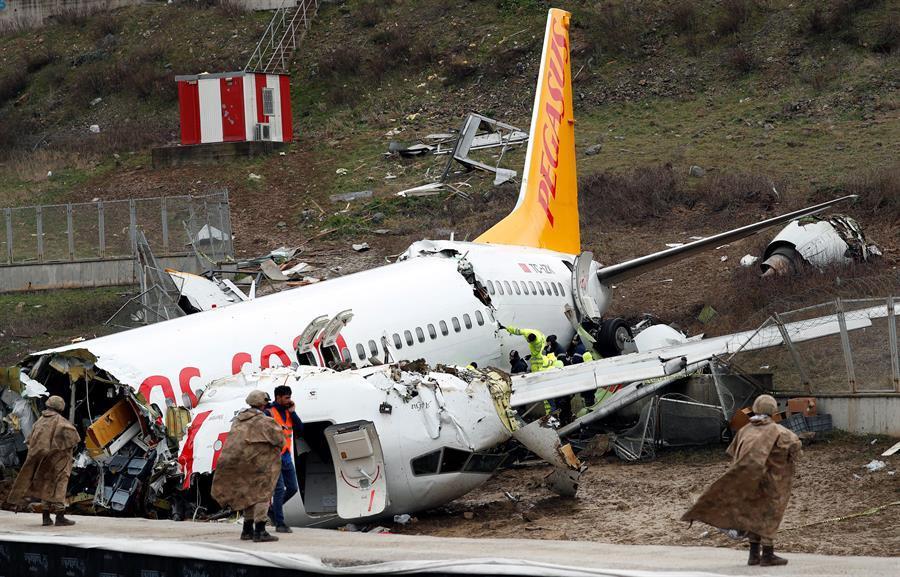
Hesitation of the pilots and the air traffic controller, rapid change in wind speed and the age-worn runway at Istanbul’s Sabiha Gökçen Airport have been pointed as possible causes of the plane accident which left three dead and 180 injured on Feb. 5.
Pegasus Airlines Flight PC2193 was landing from the western province of İzmir when it skidded off the runway on Feb. 5 in inclement weather.
The preliminary assessment of the investigation commission, assigned by the Transport and Infrastructure Ministry, focused on the possibility of a “wind shear,” which is defined as a sudden change in wind speed or direction over a short distance.
Normally, pilots are trained to avoid wind shear risks caused by microbursts and downbursts often by following a procedure of missed approach, according to an expert.
“The given tail wind limit for passenger planes is 10 knots. But, the limit decreases to five knots if the runway is wet. We see that the tail wind during the landing of this plane was 22 knots, and it even rose to 34 knots, or 61 kilometers per hour,” said retired air traffic controller Zafer Yeşilgül.
“In such a situation the air traffic control tower should definitely not give permission for landing. Besides, the pilot can also see the wind speed on his screen. So, he should have initiated a go-around even if a landing permission was given,” he added.
The decision of the two pilots, Turkish and South Korean nationals, to try for a difficult landing can be caused by a motivation to save time and fuel, aviation expert and daily Hürriyet columnist Uğur Cebeci wrote.
“Pilots always aim at landing as soon as possible to transport passengers on time. It’s a hidden pressure,” he wrote.
“If the ATC tower had acted more decisively, and if the pilot had decided to abort landing in accordance with the data, Pegasus wouldn’t have gone through such an incident. But quandary is one of the unsolved problems of aviation trainings,” said Cebeci.
Sabiha Gökçen Airport’s single age-worn runway may be a contributing factor in the accident, another expert stated.
“The runway has not been renewed for a long while. It is being used constantly and it cannot be closed as there is no other runway at this airport,” said former Deputy General Director of Civil Aviation Oktay Erdağı.
“I was flying from Sabiha Gökçen recently. Noises were heard during take-off. I realized that there was a coating problem of the runway,” he added, also saying that the waterbeds on a runway does not let the brakes of a plane work properly.
An announcement saying, “You may now use your cell phones,” was heard shortly after the touchdown, which reportedly took place near the end of the runway, and many passengers had unfastened safety belts before the plane hurtled from a height of 30 meters, according to survivors.
“I didn’t unfasten my seatbelt as the landing was rough. Those who did so may have been injured badly. The pilots applied the brake again, but the plane didn’t stop. Then there was a feeling of gliding,” said Kahraman Can Söylemez.
Alper Kulu, one of the survivors, said that the flight was “abnormal from the start to the finish.”
“It was a very turbulent flight. The plane touched down with difficulty. It was very speedy compared to other flights,” Kulu told Demirören News Agency.
He remembers hearing a voice over the public address system saying “Welcome to Istanbul” after the wheels touched down and the plane swaying left and right before it dropped into the steep ditch. The force was so strong it flipped the fixed seats in front of him completely around.
Kulu said he struggled with a broken arm to get out of the plane quickly and climb up the steep ditch, fearing an explosion and fire.
The prosecutors have taken statements from air traffic control staff and airport employees, as well as from the pilots of two other planes who aborted landings shortly before the Pegasus flight landed.
Another Pegasus Airlines plane skidded off the runway at the same Istanbul airport on Jan. 7, causing the temporary closure of the airport. There were no injuries.
In January 2018, another Boeing 737 in the Pegasus fleet slid off a runway at Trabzon Airport in northeastern Turkey. The plane came to rest in the dirt above the Black Sea with its nose pointed toward the water. No one was injured.